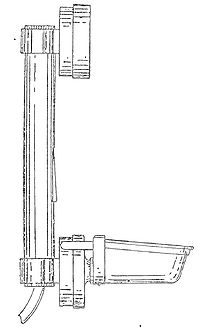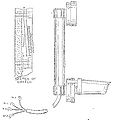Telephone, Hand, C
| Telephone, Hand, C | |
|---|---|
 Telephone, Hand, C, Mark II |
Telephone, Hand, C Mark II is intended for use with Telephone sets, Portable, C Mark II and Vibrator, telegraph, Mark I. It is made of aluminium, the handle consisting of a tube covered with leather, which is prevented from pressing the switch when shrunk with wet by an ebonite collar. The ends of the tube are closed by screw plugs, and the collars carrying the microphone and receiver cases can be removed by taking out a screw. The receiver is wound with •003-inch wire to a resistance of 120 ohms, and the microphone is of the capsule type. The mouth-piece is a leather hood, and is hinged to lie flat along the handle. The cord used is Cord, telephone, C Mark II, which terminates in hook-shaped contacts, labelled Ml, M2, Rl, R2. When used with Telephone set, Portable, C Mark II, M2 is spare.
The Mark III Telephone, Hand, C, differs from Mark II as follows : —
- (a) A fibre push fitted outside the leather cover over the pressel switch,
- (b) A fibre ear-piece fitted to the receiver in place of the pattern in Mark II.
- (c) A metal deflector fitted to transmitter as in Telephone, Hand, D Mark I, in place of the present leather one.
Related Pages
- No related pages at this time


